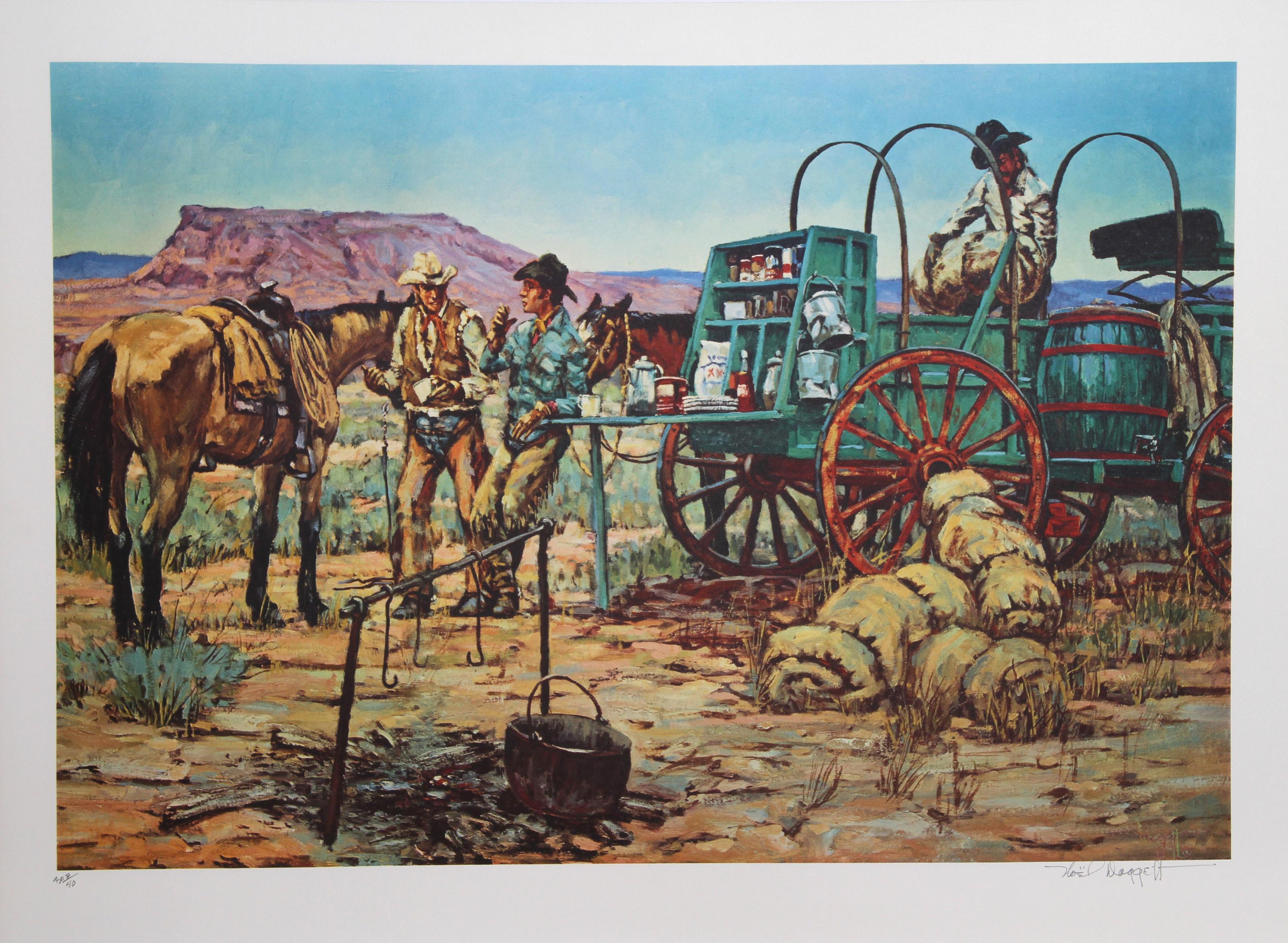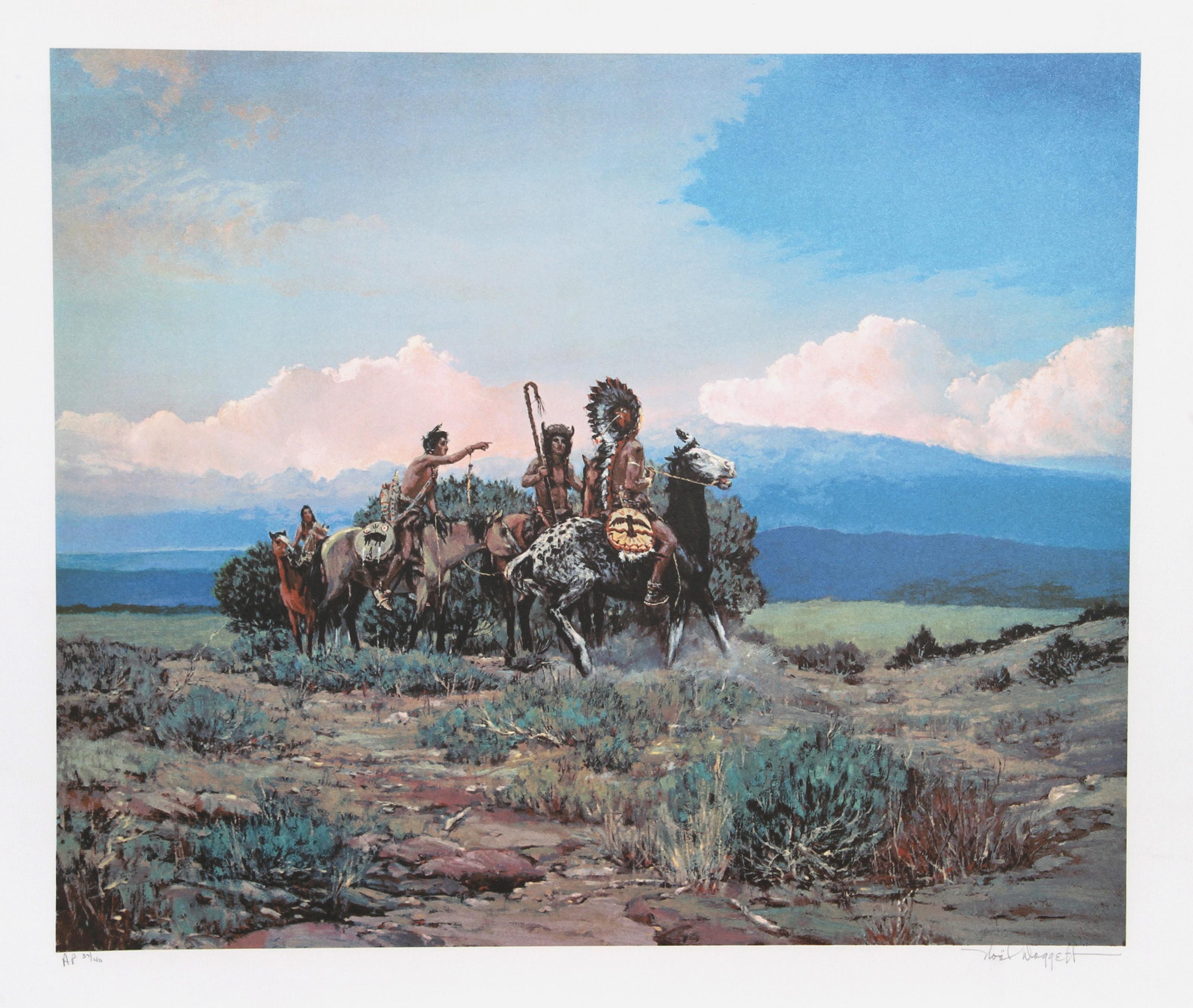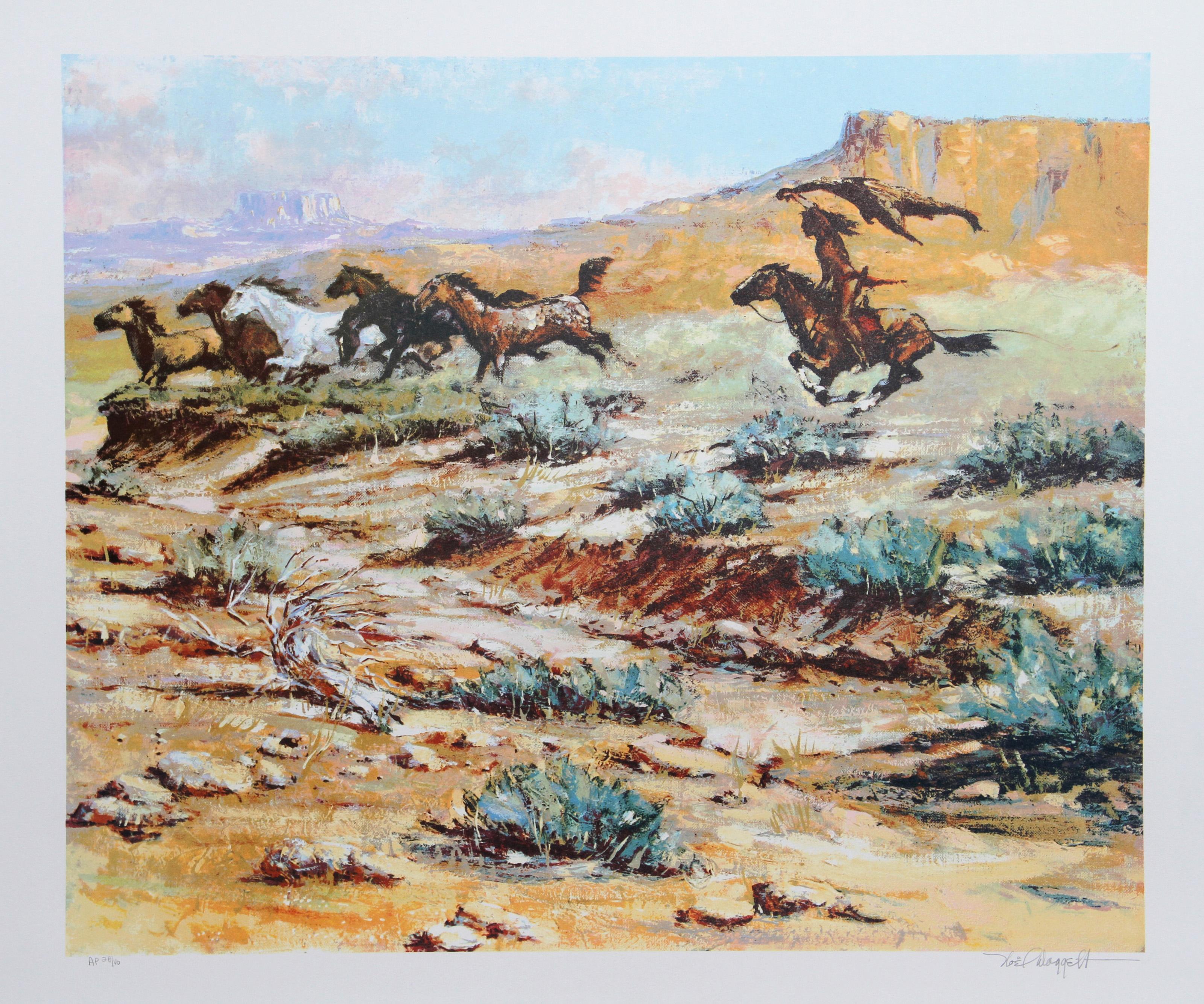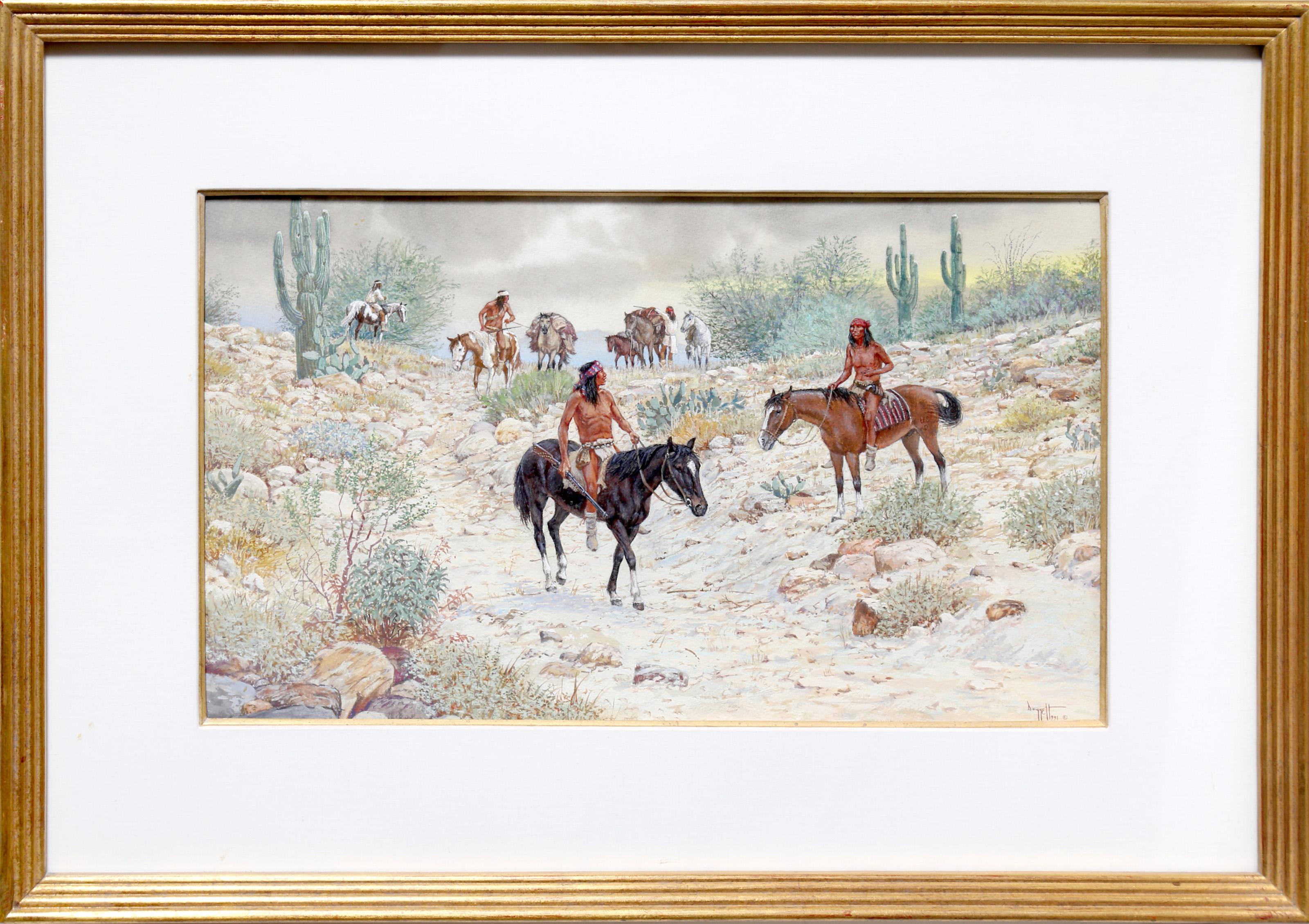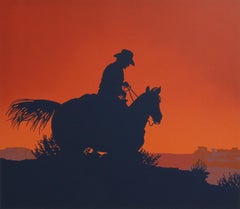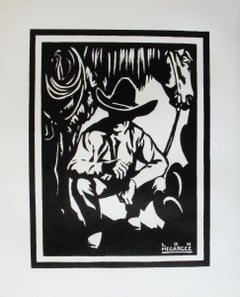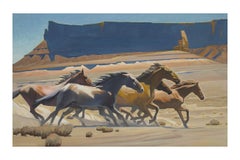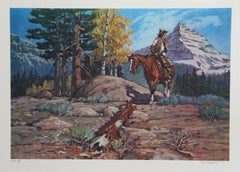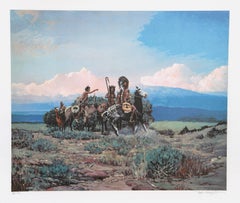Items Similar to Bomber and Buckeroos by Till Goodan, Westward Ho Company
Want more images or videos?
Request additional images or videos from the seller
1 of 5
Till GoodanBomber and Buckeroos by Till Goodan, Westward Ho Company1939
1939
$1,400
£1,086.66
€1,238.08
CA$2,000.75
A$2,178.97
CHF 1,148.89
MX$26,502.56
NOK 14,447.30
SEK 13,550.39
DKK 9,245.08
About the Item
Bomber And Buckeroos ca. 1939
Till Goodan
Offset Lithograph
PRINTS ARE IN GOOD CONDITION. PRINTS MAY HAVE SMALL FLAW ALONG EDGE OF PAPER, DOES NOT EFFECT THE PRINT IMAGE
All the prints are 26 x 31 inches, Mustang Peeler, Bombers and Buckaroos, The stranger, Guardians of the Range and Range Baby.
Note that “The Mustang Runner” is 3 inches shorter in height, 23 x 31 inches
The print by Till Goodan was originally a painting and reproduced by the Westward Ho company as a set. Westward Ho produced the most sought after Western dinnerware ever made. The most popular pattern was the Rodeo pattern by Till Goodan. He Illustrated and branded many accessories sold by the Westward Ho Company.
Tillman Parker Goodan 1896-1958
To the casual observer his paintings are exciting and colorful. To the scholars of the Western Era they are benchmarks of authenticity. Such is the style of Till Goodan. He was born Tillman Parker Goodan in Eaton, Colorado on March 27, 1896. His father was a true western pioneer, mayor of Eaton, publisher of its first newspaper, and County Commissioner for several years.
After moving to California in 1905 and settling on a little farm that bordered the Michel Cattle Ranch, Till spent much of his boyhood with the Michel sons working on their ranch. There he developed his expertise as a calf roper and the skills of a working cowboy.
As a young man Till pursued endeavors that would initially callous his emerging artistic hands. He worked for the famous Miller and Lux Ranch in California. He packed mules and ran pack trains into the Sierra Mountains. He broke horses and competed in local rodeos riding saddle broncs and roping calves. And during the quiet hours he would draw pictures of ranch life and the action of the rodeo. People began commenting on his talents as an artist.
In 1917 he left the rodeo circuit and turned his full attention to a career in art. He studied with Roger Sterrett, William Paxton, and Dana Bartlett, all highly respected California artists. Till soon became a free-lance commercial artist doing work for Grauman’s Chinese and Lowe’s Theaters, Helms Bakery and Security Bank. He later assumed a position as Art Director for the Richfield Oil Company. However, his first love was still the art of the old west, horses, cowboys, and ranching. So, he left Richfield and gave his full attention to the field of fine arts.
He did oil painting, water colors and lithographs. He drew the Gene Autry Comic Books. He illustrated and hand lettered a large collection of stories about famous bucking horses, ranches, horsemen of the world, and western gear. In association with W.C. Wentz, he started producing a complete line of western gift wares, ceramics, bronzes, leather, paper, and fabric.
By the 1930′s he was beginning to receive recognition for his western art and by the early 1940s, he and his daughter, Betty, were illustrating comic books for his longtime friend, Gene Autry. Betty was also a world champion cowgirl.
Till Goodan designs appeared in virtually every medium. But, the most famous was the four lines of dinnerware produced by Wallace China: Pioneer Trails, Longhorn, Boots and Saddle, and Rodeo. The “Rodeo” pattern was a tremendous success. The wonderful action drawings of Rodeo events surrounded by authentic cattle brands appealed to Westerners of every persuasion. “Rodeo” dinnerware graced the tables of restaurants, hotels, and ranches. Gene Autry, Roy Rogers and Bing Crosby owned sets of “Rodeoware”. Today all the dinnerware patterns are prized collectibles.
Till Goodan spent most of his life in California. He established a permanent studio/home in Hollywood and over the years he owned a ranch near the town of Lebec, along with a mountain retreat in the Sierras. He painted the California landscape, but, many of his paintings reflect his love for the Arizona and New Mexico desert. His artwork was always authentic in every detail because he painted what he knew from first hand experience.
He enjoyed his western lifestyle until the day he died. On May 24, 1958, while serving as Grand Marshall of the Tulare California Rodeo, he succumbed to a heart attack while sitting on his horse. Serious collectors seek out all of Till Goodan’s work–not just the Westward Ho designed dinnerware lines. Till Goodan was a versatile artist whose love for the rodeo and the west was reflected in all of his work. Western decorated tablecloths, ties, prints, calendars, postcards, and paintings make up the wide variety of collectibles designed by Till Goodan.
True West
- Creator:Till Goodan (1896 - 1958, American)
- Creation Year:1939
- Dimensions:Height: 26 in (66.04 cm)Width: 31 in (78.74 cm)
- Medium:
- Movement & Style:
- Period:
- Condition:
- Gallery Location:Phoenix, AZ
- Reference Number:1stDibs: LU2623215179302
About the Seller
No Reviews Yet
Vetted Professional Seller
Every seller passes strict standards for authenticity and reliability
1stDibs seller since 2023
8 sales on 1stDibs
- ShippingRetrieving quote...Shipping from: Phoenix, AZ
- Return Policy
Authenticity Guarantee
In the unlikely event there’s an issue with an item’s authenticity, contact us within 1 year for a full refund. DetailsMoney-Back Guarantee
If your item is not as described, is damaged in transit, or does not arrive, contact us within 7 days for a full refund. Details24-Hour Cancellation
You have a 24-hour grace period in which to reconsider your purchase, with no questions asked.Vetted Professional Sellers
Our world-class sellers must adhere to strict standards for service and quality, maintaining the integrity of our listings.Price-Match Guarantee
If you find that a seller listed the same item for a lower price elsewhere, we’ll match it.Trusted Global Delivery
Our best-in-class carrier network provides specialized shipping options worldwide, including custom delivery.More From This Seller
View AllDown to the Valley by Bill Schenck
By Bill Schenck
Located in Phoenix, AZ
Down in the Valley
Bill Schenck
Serigraph 46/50
Edition of 50
Image size: 25 x 29 inches
Paper size: 31 x 35 inches
SHIPPING CHARGES INCLUDE SHIPPING, PACKAGING & INSURANCE
UNFRAM...
Category
1990s Contemporary Figurative Prints
Materials
Screen
Longhorns by Lon Megargee
Located in Phoenix, AZ
Lon Megargee 1883-1960
"Self Portrait"
Wood block print
Signed in plate, lower right
Image size: 15.63 x 12 inches
Frame size xx x xx inches
Creator of S...
Category
1930s American Impressionist Animal Prints
Materials
Screen
Misfit by Greg Singley
Located in Phoenix, AZ
Title: Misfit
Artist: Greg Singley
Signed original signature
Archival Pigment Print,
100% Rag Paper 300 gm
Paper size: 24 x34 inches
Image Size: 20 x 30 inches
Greg Singley
Greg Singley – was born in 1950 in Greensboro, Alabama. He received his Associates Degree at Walker Collage Jasper Alabama and furthered his college education at the University of South Alabama, Mobile Alabama. He attended the revered Ringling School of Art for his art training in Sarasota Florida and graduated with honors with a certificate in commercial illustration.
In 1978 Singley moved to Phoenix Arizona to pursue his passion for western art and illustration. He worked for several years as an art director for Phoenix Public News and as a freelance illustrator and at the same time experienced sales of Native American and Western Landscape in several Arizona galleries which include Ratliff Williams Gallery, Sedona Arizona, Fagan Peterson Fine Art, Scottsdale and the Dan May Gallery, Scottsdale Arizona.
After a foray into freelance illustration Singley sought representation for his varied abilities and interest in fine art and found the Phoenix Art Group...
Category
2010s Contemporary Figurative Prints
Materials
Archival Pigment
Wide Open by Greg Singley
Located in Phoenix, AZ
Title: Wide Open
Artist: Greg Singley
Archival Pigment Print
100% Cotton Rag 300gm
Image size: 20 x 32.625
Paper size: 24 x 36 inches
Greg Singley
Greg Singley – was born in 1950 in Greensboro, Alabama. He received his Associates Degree at Walker Collage Jasper Alabama and furthered his college education at the University of South Alabama, Mobile Alabama. He attended the revered Ringling School of Art for his art training in Sarasota Florida and graduated with honors with a certificate in commercial illustration.
In 1978 Singley moved to Phoenix Arizona to pursue his passion for western art and illustration. He worked for several years as an art director for Phoenix Public News and as a freelance illustrator and at the same time experienced sales of Native American and Western Landscape in several Arizona galleries which include Ratliff Williams Gallery, Sedona Arizona, Fagan Peterson Fine Art, Scottsdale and the Dan May Gallery, Scottsdale Arizona.
After a foray into freelance illustration Singley sought representation for his varied abilities and interest in fine art and found the Phoenix Art Group...
Category
2010s Contemporary Figurative Prints
Materials
Archival Pigment
The Sheepherder by Lon Megargee
Located in Phoenix, AZ
Lon Megargee 1883-1960
"The Sheepherder"
Wood block print
Signed in plate, lower right
Image size: 10 x 10 inches
Frame size 22 x 22 inches
Creator of Stetson's hat logo "Last Drop from his Hat"
Lon Megargee
1883 - 1960
At age 13, Lon Megargee came to Phoenix in 1896 following the death of his father in Philadelphia. For several years he resided with relatives while working at an uncle’s dairy farm and at odd jobs. He returned to Philadelphia in 1898 – 1899 in order to attend drawing classes at the Pennsylvania Academy of the Fine Arts. Back in Phoenix in 1899, he decided at the age of 16 to try to make his living as a cowboy.
Lon moved to the cow country of Wickenburg, Arizona where he was hired by Tex Singleton’s Bull Ranch. He later joined the Three Bar R. . . and after a few years, was offered a job by Billy Cook of the T.T. Ranch near New River. By 1906, Megargee had learned his trade well enough to be made foreman of Cook’s outfit.
Never shy about taking risks, Lon soon left Cook to try his own hand at ranching. He partnered with a cowpuncher buddy, Tom Cavness, to start the El Rancho Cinco Uno at New River. Unfortunately, the young partners could not foresee a three-year drought that would parch Arizona, costing them their stock and then their hard-earned ranch.
Breaking with his romantic vision of cowboy life, Megargee finally turned to art full time. He again enrolled at the Pennsylvania Academy of Art and then the Los Angeles School of Art and Design during 1909 – 1910. The now well-trained student took his first trip to paint “en plein air” (outdoors) to the land of Hopi and Navajo peoples in northern Arizona. After entering paintings from this trip in the annual Territorial Fair at Phoenix, in 1911, he surprisingly sold his first oil painting to a major enterprise – the Santa Fe Railroad . . . Lon received $50 for “Navajos Watching the Santa Fe Train.” He soon sold the SFRR ten paintings over the next two years. For forty years the railroad was his most important client, purchasing its last painting from him in 1953.
In a major stroke of good fortune during his early plein-air period, Megargee had the opportunity to paint with premier artist, William R. Leigh (1866 – 1955). Leigh furnished needed tutoring and counseling, and his bright, impressionistic palette served to enhance the junior artist’s sense of color and paint application. In a remarkable display of unabashed confidence and personable salesmanship, Lon Megargee, at age 30, forever linked his name with Arizona art history. Despite the possibility of competition from better known and more senior artists, he persuaded Governor George Hunt and the Legislature in 1913 to approve 15 large, historic and iconic murals for the State Capitol Building in Phoenix. After completing the murals in 1914, he was paid the then princely sum of roughly $4000. His Arizona statehood commission would launch Lon to considerable prominence at a very early point in his art career.
Following a few years of art schooling in Los Angeles, and several stints as an art director with movie studios, including Paramount, Megargee turned in part to cover illustrations for popular Western story magazines in the 1920s.
In the 1920s, as well, Lon began making black and white prints of Western types and of genre scenes from woodblocks. These prints he generally signed and sold singly. In 1933, he published a limited edition, signed and hard-cover book (about 250 copies and today rare)containing a group of 28 woodblock images. Titled “The Cowboy Builds a Loop,” the prints are noteworthy for strong design, excellent draftsmanship, humanistic and narrative content, and quality. Subjects include Southwest Indians and cowboys, Hispanic men and women, cattle, horses, burros, pioneers, trappers, sheepherders, horse traders, squaw men and ranch polo players. Megargee had a very advanced design sense for simplicity and boldness which he demonstrated in how he used line and form. His strengths included outstanding gestural (action) art and strong figurative work. He was superb in design, originality and drawing, as a study of his prints in the Hays collection reveals.
In 1944, he published a second group of Western prints under the same title as the first. Reduced to 16 images from the original 28 subjects, and slightly smaller, Lon produced these prints in brown ink on a heavy, cream-colored stock. He designed a sturdy cardboard folio to hold each set. For the remainder of his life, Lon had success selling these portfolios to museum stores, art fairs and shows, and to the few galleries then selling Western art.
Drawing on real working and life experiences, Lon Megargee had a comprehensive knowledge, understanding and sensitivity for Southwestern subject matter. Noted American modernist, Lew Davis...
Category
Early 20th Century American Impressionist Figurative Prints
Materials
Woodcut
The Bronc by Lon Megargee
Located in Phoenix, AZ
Lon Megargee 1883-1960
"The Bronc"
Wood block print
Signed in plate, lower right
Image size: 9 x 10 inches
Frame size 21 x 21.5 inches
Creator of Stetson's hat logo "Last Drop from his Hat"
Lon Megargee
1883 - 1960
At age 13, Lon Megargee came to Phoenix in 1896 following the death of his father in Philadelphia. For several years he resided with relatives while working at an uncle’s dairy farm and at odd jobs. He returned to Philadelphia in 1898 – 1899 in order to attend drawing classes at the Pennsylvania Academy of the Fine Arts. Back in Phoenix in 1899, he decided at the age of 16 to try to make his living as a cowboy.
Lon moved to the cow country of Wickenburg, Arizona where he was hired by Tex Singleton’s Bull Ranch. He later joined the Three Bar R. . . and after a few years, was offered a job by Billy Cook of the T.T. Ranch near New River. By 1906, Megargee had learned his trade well enough to be made foreman of Cook’s outfit.
Never shy about taking risks, Lon soon left Cook to try his own hand at ranching. He partnered with a cowpuncher buddy, Tom Cavness, to start the El Rancho Cinco Uno at New River. Unfortunately, the young partners could not foresee a three-year drought that would parch Arizona, costing them their stock and then their hard-earned ranch.
Breaking with his romantic vision of cowboy life, Megargee finally turned to art full time. He again enrolled at the Pennsylvania Academy of Art and then the Los Angeles School of Art and Design during 1909 – 1910. The now well-trained student took his first trip to paint “en plein air” (outdoors) to the land of Hopi and Navajo peoples in northern Arizona. After entering paintings from this trip in the annual Territorial Fair at Phoenix, in 1911, he surprisingly sold his first oil painting to a major enterprise – the Santa Fe Railroad . . . Lon received $50 for “Navajos Watching the Santa Fe Train.” He soon sold the SFRR ten paintings over the next two years. For forty years the railroad was his most important client, purchasing its last painting from him in 1953.
In a major stroke of good fortune during his early plein-air period, Megargee had the opportunity to paint with premier artist, William R. Leigh (1866 – 1955). Leigh furnished needed tutoring and counseling, and his bright, impressionistic palette served to enhance the junior artist’s sense of color and paint application. In a remarkable display of unabashed confidence and personable salesmanship, Lon Megargee, at age 30, forever linked his name with Arizona art history. Despite the possibility of competition from better known and more senior artists, he persuaded Governor George Hunt and the Legislature in 1913 to approve 15 large, historic and iconic murals for the State Capitol Building in Phoenix. After completing the murals in 1914, he was paid the then princely sum of roughly $4000. His Arizona statehood commission would launch Lon to considerable prominence at a very early point in his art career.
Following a few years of art schooling in Los Angeles, and several stints as an art director with movie studios, including Paramount, Megargee turned in part to cover illustrations for popular Western story magazines in the 1920s.
In the 1920s, as well, Lon began making black and white prints of Western types and of genre scenes from woodblocks. These prints he generally signed and sold singly. In 1933, he published a limited edition, signed and hard-cover book (about 250 copies and today rare)containing a group of 28 woodblock images. Titled “The Cowboy Builds a Loop,” the prints are noteworthy for strong design, excellent draftsmanship, humanistic and narrative content, and quality. Subjects include Southwest Indians and cowboys, Hispanic men and women, cattle, horses, burros, pioneers, trappers, sheepherders, horse traders, squaw men and ranch polo players. Megargee had a very advanced design sense for simplicity and boldness which he demonstrated in how he used line and form. His strengths included outstanding gestural (action) art and strong figurative work. He was superb in design, originality and drawing, as a study of his prints in the Hays collection reveals.
In 1944, he published a second group of Western prints under the same title as the first. Reduced to 16 images from the original 28 subjects, and slightly smaller, Lon produced these prints in brown ink on a heavy, cream-colored stock. He designed a sturdy cardboard folio to hold each set. For the remainder of his life, Lon had success selling these portfolios to museum stores, art fairs and shows, and to the few galleries then selling Western art.
Drawing on real working and life experiences, Lon Megargee had a comprehensive knowledge, understanding and sensitivity for Southwestern subject matter. Noted American modernist, Lew Davis...
Category
Early 20th Century American Impressionist Figurative Prints
Materials
Woodcut
You May Also Like
A Last Look Back, American Western Art Lithograph by Noel Daggett
By Noel Daggett
Located in Long Island City, NY
Noel Daggett, American (1925 - 2005) - A Last Look Back, Year: circa 1979, Medium: Lithograph, signed and numbered in pencil, Edition: 300, AP 40, Image Size: 17.5 x 25 inches, S...
Category
1970s American Realist Figurative Prints
Materials
Lithograph
Let's Move 'Em, American Western Art Lithograph by Noel Daggett
By Noel Daggett
Located in Long Island City, NY
Noel Daggett, American (1925 - 2005) - Let's Move 'Em, Year: circa 1979, Medium: Lithograph, signed and numbered in pencil, Edition: 300, AP 40, Image Size: 18.5 x 27 inches, Siz...
Category
1970s American Realist Animal Prints
Materials
Lithograph
Approach of a Rider, American Western Art Lithograph by Noel Daggett
By Noel Daggett
Located in Long Island City, NY
Noel Daggett, American (1925 - 2005) - Approach of a Rider, Year: circa 1979, Medium: Lithograph, signed and numbered in pencil, Edition: 300, AP 40, Image Size: 19 x 23 inches, ...
Category
1970s American Realist Figurative Prints
Materials
Lithograph
Approach of a Rider, Western Oil Painting by Noel Daggett
By Noel Daggett
Located in Long Island City, NY
Approach of a Rider
Noel Daggett, American (1925–2005)
Date: 1980
Oil on Canvas, signed
Size: 30 x 36 in. (76.2 x 91.44 cm)
Frame Size: 35 x 41 inches
Category
1980s American Realist Landscape Paintings
Materials
Oil
Mustangs on the Run, American Western Art Lithograph by Noel Daggett
By Noel Daggett
Located in Long Island City, NY
Noel Daggett, American (1925 - 2005) - Mustangs on the Run, Year: circa 1979, Medium: Lithograph, signed and numbered in pencil, Edition: 300, AP 40, Image Size: 19 x 23.5 inches...
Category
1970s American Realist Animal Prints
Materials
Lithograph
Good Takings, American Western Art Gouache Painting on Board by Noel Daggett
By Noel Daggett
Located in Long Island City, NY
Noel Daggett, American (1925 - 2005) - Good Takings, Year: 1991, Medium: Gouache on Board, signed and dated l.r., Size: 10 in. x 17 in. (25.4 cm x 43.18 cm), Frame Size: 17.5 x 2...
Category
1990s American Realist Figurative Drawings and Watercolors
Materials
Gouache
More Ways To Browse
Vintage Bomber
Leather Horse With Leather Saddle
Used Restaurant Tables
Vintage Bucking Horse
Cattle Brand
Dana Bartlett
Lithograph Picasso 1957
Make Art Not War
Marc Chagall Poster Framed
Marc Chagall The Lovers
Marino Marini Shakespeare
Mary Cassatt Etchings
Matisse Signed Print
Max Baer
Max Beckmann Drypoint
May Belfort
Melanie Taylor Kent
Mexican Revolution Art

